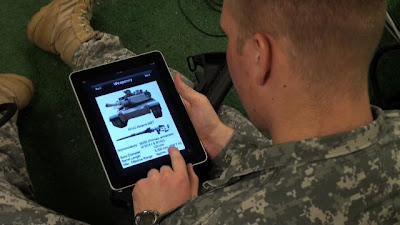 |
| Photo credit U.S. Army The Ammunition Multimedia Encyclopedia allows military and civilian personnel to have access to munitions information, even in the most remote locations. |
MCALESTER, Okla., April 26, 2011 -- Imagine a Soldier in the hills of Afghanistan or civilian supporting training in a remote area in the back woods somewhere needs critical information on a new piece of munitions. Where can they go to access this information? They can't call back to base. They can't carry a rucksack full reference books with them.
The Defense Ammunition Center, or DAC, partnering with Serco Inc. and Oklahoma State University, has responded to this need. The Ammunition Multimedia Encyclopedia, or AME, was created to provide Soldiers and ammunition civilians in the field a reach-back information center that provides key data related to new munitions items and inspection points.
AME uses virtual reality technology to create a realistic, hands-on training environment and can be used on anything from a desktop computer to an iPhone.
"AME is an electronic performance support tool," explained Upton Shimp, associate director of Operations and Training with the Defense Ammunition Center. "The goal of AME is to provide a surveillance tool to support personnel inspecting munitions. It provides an encyclopedia of currently used munitions which can be used for inspection and refresher training."
AME has been in use for three years. The first year was the pilot phase, folowed by a second year of compiling information for the web version. The final year involved taking the AME to the application environment.
The AME was developed by a small group of Oklahoma State University, or OSU, students, led by Ramesh Sharda, director, Institute for Research in Information Systems, OSU Spears School of Business.
"Designing the AME has been a tremendous learning experience for our students," said Sharda. "Students are gaining knowledge about immersive technology, image editing, iPhone, iPad development, and security regulations for these devices."
"Working with the students to develop new technology that can benefit warfighters has been rewarding for everyone on the project," Sharda said. "In addition, it provides the students with tremendous learning experiences, making them attractive to their prospective employers."
Currently, there are 180 munitions items in the AME available for viewing through the Ammunition Community of Practice https://acc.dau.mil/ammo.
Additionally, 100 munitions items will be added in 2011, totaling 280 different munitions items by the end of this fiscal year.
"Munitions items can be searched by the Department of Defense Identification Code or by name," said Shimp, making AME a very user-friendly tool, that saves time and provides 24-hour munitions support.
Currently, the AME application is targeted toward Quality Assurance Specialist (Ammunition Surveillance) and Ammo Logistics Assistance Representatives in the field who are handling, packaging and inspecting ammunition.
"The plan for the applications environment is to make the AME conducive to the customer," said Sharda. "All information will be uploaded into the memory of mobile application device and used as a reference in the field."
Development of the AME is a win-win situation. It allows military and civilian personnel to have access to munitions information, even in the most remote locations, and provides hands-on training and experience for OSU business information technology students.
The Defense Ammunition Center, or DAC, partnering with Serco Inc. and Oklahoma State University, has responded to this need. The Ammunition Multimedia Encyclopedia, or AME, was created to provide Soldiers and ammunition civilians in the field a reach-back information center that provides key data related to new munitions items and inspection points.
AME uses virtual reality technology to create a realistic, hands-on training environment and can be used on anything from a desktop computer to an iPhone.
"AME is an electronic performance support tool," explained Upton Shimp, associate director of Operations and Training with the Defense Ammunition Center. "The goal of AME is to provide a surveillance tool to support personnel inspecting munitions. It provides an encyclopedia of currently used munitions which can be used for inspection and refresher training."
AME has been in use for three years. The first year was the pilot phase, folowed by a second year of compiling information for the web version. The final year involved taking the AME to the application environment.
The AME was developed by a small group of Oklahoma State University, or OSU, students, led by Ramesh Sharda, director, Institute for Research in Information Systems, OSU Spears School of Business.
"Designing the AME has been a tremendous learning experience for our students," said Sharda. "Students are gaining knowledge about immersive technology, image editing, iPhone, iPad development, and security regulations for these devices."
"Working with the students to develop new technology that can benefit warfighters has been rewarding for everyone on the project," Sharda said. "In addition, it provides the students with tremendous learning experiences, making them attractive to their prospective employers."
Currently, there are 180 munitions items in the AME available for viewing through the Ammunition Community of Practice https://acc.dau.mil/ammo.
Additionally, 100 munitions items will be added in 2011, totaling 280 different munitions items by the end of this fiscal year.
"Munitions items can be searched by the Department of Defense Identification Code or by name," said Shimp, making AME a very user-friendly tool, that saves time and provides 24-hour munitions support.
Currently, the AME application is targeted toward Quality Assurance Specialist (Ammunition Surveillance) and Ammo Logistics Assistance Representatives in the field who are handling, packaging and inspecting ammunition.
"The plan for the applications environment is to make the AME conducive to the customer," said Sharda. "All information will be uploaded into the memory of mobile application device and used as a reference in the field."
Development of the AME is a win-win situation. It allows military and civilian personnel to have access to munitions information, even in the most remote locations, and provides hands-on training and experience for OSU business information technology students.